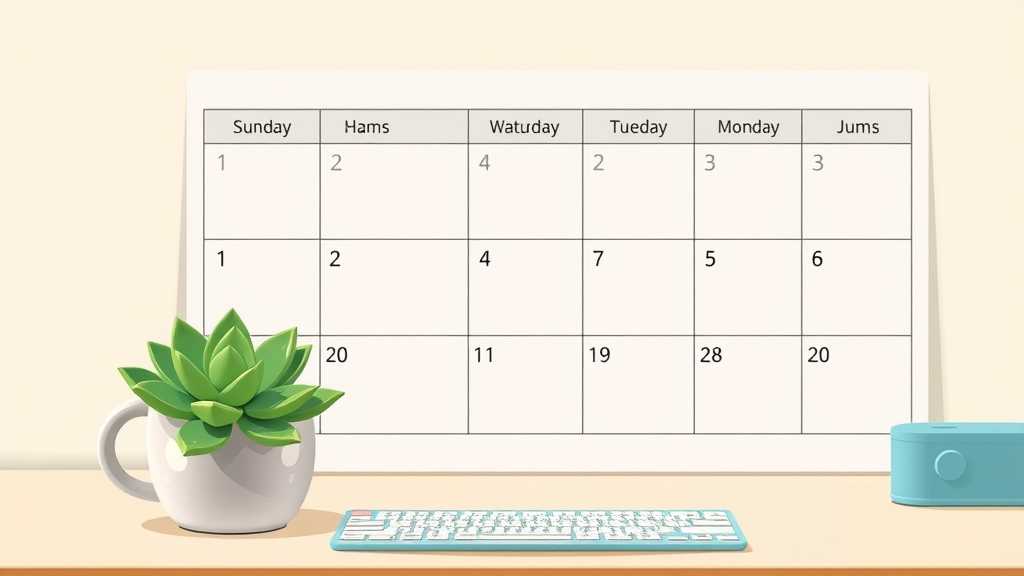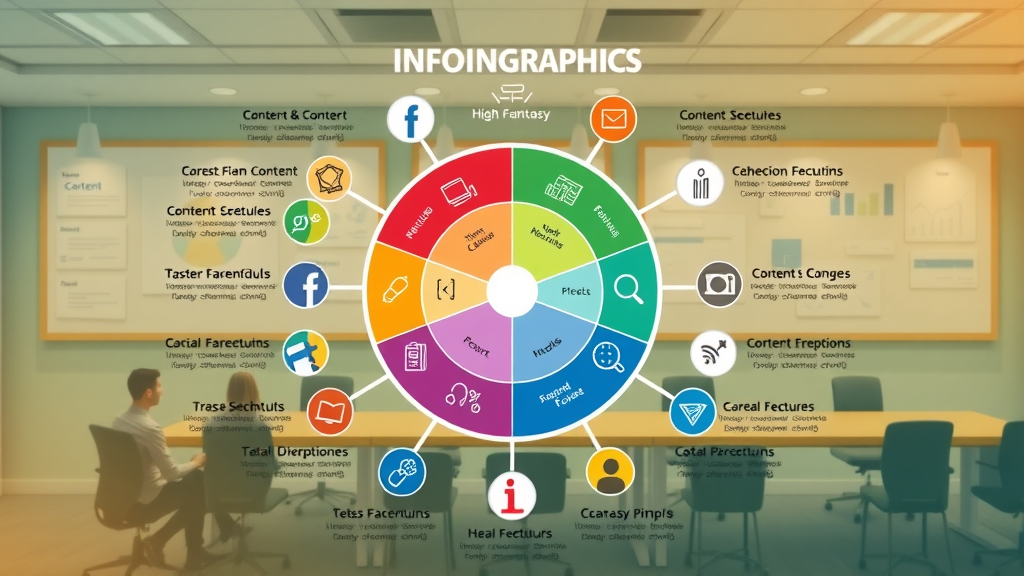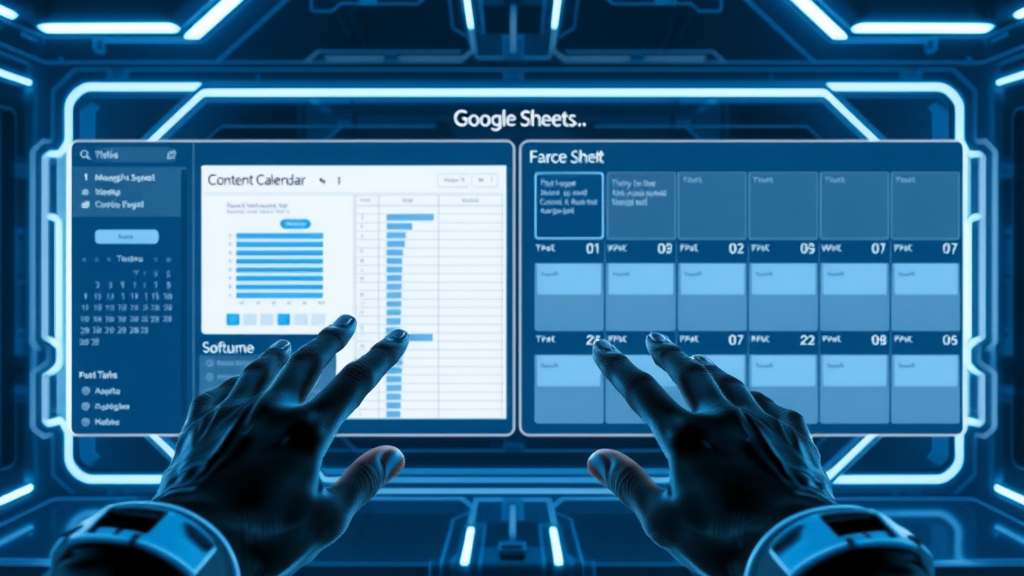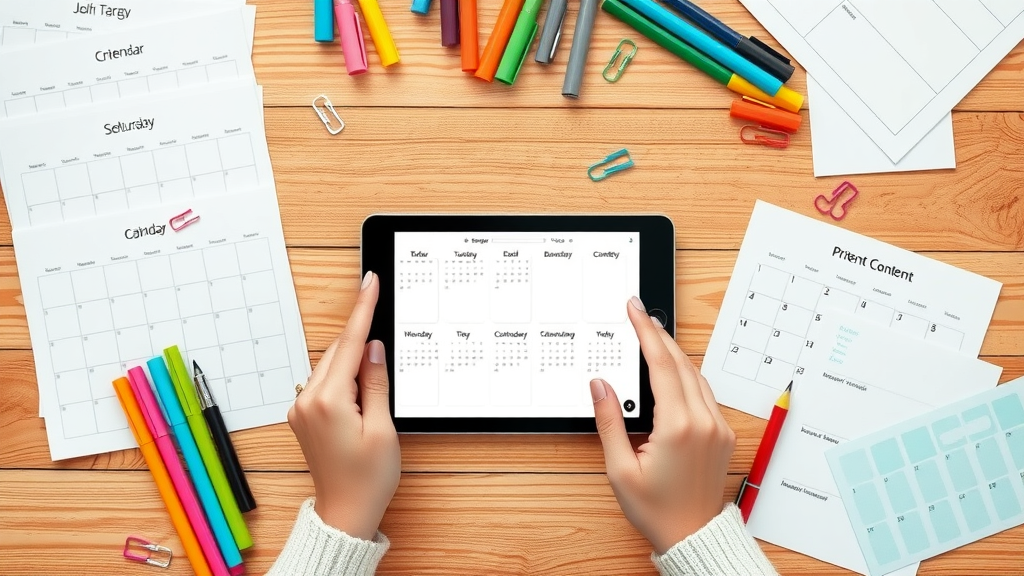Did you know that marketers who use a structured content calendar are 60% more successful in achieving their goals? If your social media or media content feels chaotic, this guide will reveal the simple hack that transforms overwhelming planning into a seamless, strategic powerhouse. Ready to silence the content chaos and unlock your team’s creative potential? You’re about to discover the essential tools, templates, and workflows that will make every campaign count.

Unlocking the Power of a Content Calendar: The Startling Fact Behind Organized Social Media
- Recent studies show that marketers using a structured content calendar are 60% more successful in achieving their content goals. Discover how a simple hack can silence the chaos and bring clarity to your campaign planning.
Keeping up with the ever-changing demands of social media and media content creation often feels like chasing your tail. However, harnessing the power of an effective content calendar provides a strategic framework for managing your social media posts, content ideas, and marketing campaigns in a streamlined fashion. A content calendar doesn’t just organize dates—it aligns your team, brings visibility to your posting schedule, and ensures that every piece of content serves your overall business objectives.
Imagine replacing last-minute panic with a methodical approach where every media post , blog entry, and social campaign fits perfectly within a planned content strategy. By implementing even the most basic content calendar template, a marketing team can track deliverables, schedule posts across platforms, and adapt to feedback in real time. The results? Increased productivity, improved accountability, and, most importantly, a consistent brand voice across all channels.
What This Guide on Content Calendar Mastery Will Teach You
- The essential components of a results-driven content calendar
- Step-by-step instructions for building your content calendar
- Proven templates for effective calendar planning
- Tools and strategies for organizing social media and media content
- Expert tips to maintain and evolve your content plan
In this comprehensive guide, you’ll uncover the actionable strategies top marketers use to craft the perfect content calendar . From determining which calendar tool or calendar template works best for your needs to expert workflows for managing your social media calendar , each section is designed to equip you with tactics to end content chaos forever. Whether you’re building your first media content calendar or refining an enterprise workflow, the practical advice inside will set you up for consistent content marketing success.
Along the way, you’ll access free resources, step-by-step walkthroughs, and downloadable templates that you can start using right away. You’ll also learn how to automate processes, measure results, and keep your entire media team on the same page—no matter how dynamic the digital landscape becomes.

The Anatomy of a Winning Content Calendar for Social Media and Beyond
Defining the Content Calendar: More Than Just Dates
- Explore the fundamental role of a content calendar in aligning social media calendar efforts with business goals and uncovering the pain points solved by effective calendar planning.
A content calendar is far more than a list of publishing dates. It is the central nervous system for your brand’s content creation strategy, guiding every media post , promotional push, and campaign milestone. By documenting who owns what, when it needs to launch, and where it’s to be published, a content calendar gives clarity and accountability to everyone involved. No more missed deadlines, duplicate topics, or confused social teams—every content idea and date and time is accounted for.
Critically, using a media content calendar bridges the gap between strategy and execution. It solves pain points like version control, cross-team collaboration, and last-minute scramble to fill gaps in your posting schedule . When a media team adopts a robust calendar tool, they’re empowered to align every content initiative with bigger business objectives—making sure that each media post counts towards measurable goals.
The benefit is twofold: you streamline your content workflow while unlocking valuable analytics insights that inform your next round of content planning. Whether your focus is on social media content , blogs, email, or video campaigns, a central calendar template ensures nothing gets overlooked. The time and confusion saved translate directly to better content performance and higher ROI.
Key Elements in a Modern Content Calendar Template
| Content Type | Social Media Platforms | Publishing Schedule | Responsible Team Members | Deadlines |
|---|---|---|---|---|
| Blog Post | Website, Facebook, LinkedIn | Every Monday | Content Writer, Editor | Friday Prior |
| Social Media Post | Instagram, Twitter, TikTok | Daily at 10am | Social Media Team | 1 Day Prior |
| Video Content | YouTube, Facebook, Reels | Monthly | Video Producer, Editor | 5 Days Before Publish |
| Email Newsletter | Subscribers List | Bi-weekly Thursdays | Marketing Manager | 2 Days Before Send |
| Media Content | All Platforms | Aligned with Campaigns | Media Team | Set per Campaign |
Leading content calendar templates share key features—comprehensive publishing schedule , cross-platform tracking, clear accountability, and flexible columns for custom needs. The right calendar template will help your marketing team manage the full spectrum of social media content and media content calendar needs in one place, keeping your workflow organized and actionable.

Social Media Content: Creating a Cohesive Media Calendar
Building Your Social Media Calendar Template From Scratch
- Practical walkthrough on how to design a tailor-made social media calendar using free and paid online calendar tools like Google Sheets and specialized content planner applications.
To construct an effective social media calendar template from scratch, begin by listing all the platforms you actively use—Instagram, Facebook, LinkedIn, Twitter, and others. Using a free Google Sheet or an advanced content planner, define columns for content type, date and time, social media platform, responsible team member, and approval status. Populate your calendar template with upcoming campaigns, recurring social media posts , and placeholders for ad hoc content ideas.
Don’t forget to include a column for “status” so the marketing team knows if a social post is in draft, under review, or scheduled. Many specialized calendar tool options automatically send reminders to the assigned team members and integrate with workflow management software. Google Sheets remains a popular choice because of its real-time editing features, while tools like Trello, Asana, and dedicated content planners cater to complex workflows with multiple contributors.
Once your initial social media content calendar is structured, begin populating it with content ideas by reviewing your marketing plan, editorial calendar, and upcoming events. Regularly review and update the schedule to account for performance insights and shifting priorities. This step-by-step process ensures every media post fits seamlessly into a cohesive media calendar and supports omnichannel marketing.
Advanced Media Content Calendar Strategies for Brands
- Integrate your social media content calendar with campaign objectives, including thematic planning, seasonal media content, and cross-platform social media post scheduling for omnichannel success.
After you’ve mastered your basic media content calendar template , elevate your strategy with advanced tactics like theme-based planning and seasonal content mapping. By dedicating weeks or months to specific campaigns, holidays, or product launches, your social media posts and media content can be timed for maximum impact. Integrate your social media calendar with your overarching content plan, aligning publishing dates with business objectives, promotional events, and emergent trends.
Cross-platform synchronization is vital—create a single source of truth for all scheduled posts, whether for social, email, blogs, or video. This approach prevents gaps in your promotional rhythm and ensures that your brand message is reinforced everywhere your audience engages. Leverage analytics within your media content calendar to optimize timing, content types, and platform selection, refining your process based on past performance to boost ROI.
Many leading brands use workflow automation features to streamline approval processes, integrating their content planner with analytics dashboards, graphic design apps like Canva, and even audience engagement tools. The result is a scalable and resilient content process ready for both daily publishing and large-scale campaigns.
Choosing the Best Content Calendar Tool and Template for Efficiency

Features That Set Apart the Top Content Calendar Templates
- Evaluate integration options, scheduling flexibility, analytics compatibility, and collaboration features in modern calendar tools. Compare media calendar and social media calendar template options.
The right content calendar template can revolutionize your publishing process. Look for features that promote seamless integration with existing workflows, such as direct connections to your CMS, scheduling apps, or graphic design platforms. Analytics compatibility is essential; your calendar tool should allow you to track engagement per piece of content, measure posting schedule consistency, and monitor cross-channel performance in real time.
Collaboration tools are another must-have. Whether you’re using a Google Sheet , advanced software, or a custom calendar tool , real-time commenting, permission settings, and version histories ensure the entire media team remains aligned. Some platforms even offer automation options for approval workflows, asset management, and customized publishing schedules, reducing manual tasks and freeing up time for creative strategy.
Google Sheets vs. Dedicated Calendar Tools: What’s Right for Your Team?
- Compare the benefits and drawbacks of using Google Sheets, Excel, Trello, Asana, and specialized content planner software for your content calendar needs.
Google Sheets is ideal for small teams or those just starting out—it’s free, highly customizable, and familiar to most contributors. However, as your campaigns scale and complexity grows, you may crave the automation and analytics available through dedicated calendar tool platforms like Asana, Trello, or specialty content planner apps. These options provide richer dashboards, integrations, and automation but often require a subscription investment.
Choosing between a spreadsheet and a platform depends on your business size, number of contributors, and campaign complexity. For nimble teams managing straightforward campaigns, Google Sheets offers flexibility and accessibility. Larger businesses or media teams with evolving needs may prefer a robust calendar tool offering user roles, asset storage, and native publishing functions.
| Tool | Best For | Key Strengths | Potential Drawbacks |
|---|---|---|---|
| Google Sheets | Small Teams/Beginners | Free, customizable, real-time collaboration | Manual tracking, limited automation |
| Excel | Traditional Workflows | Offline access, customizable tables | No seamless cloud collaboration |
| Trello | Agile Campaigns | Visual boards, drag-and-drop scheduling | Limited analytics in free version |
| Asana | Large, Cross-Functional Teams | Project milestones, automation, robust reporting | Learning curve, subscription cost |
| Specialized Content Planner | Enterprises/Advanced Users | User roles, asset library, approvals, integrations | Monthly cost, setup complexity |

Implementing Your Content Calendar: From Idea to Execution
Developing a Reliable Content Plan to Fill Your Media Calendar
- Guidelines for brainstorming, prioritizing, and calendaring diverse content formats: blogs, social media post, video, email, and media content deployments.
A robust content plan is the backbone of any successful media content calendar . Begin your planning with a team brainstorming session to generate content ideas that align with your business and campaign goals. Once you’ve assembled a rich list of ideas, evaluate them based on seasonality, audience interest, and channel relevance. Assign each prioritized piece of content to a posting date, responsible owner, and preferred social media platform within your calendar template .
Consistency and balance are critical—a mix of blog posts, video content, email newsletters, and social media posts will keep your audience engaged across every channel. Your media calendar should map out these formats according to frequency, audience needs, and campaign objectives. Don’t forget to leave space for spontaneous posts that capitalize on trends or unexpected opportunities.
To ensure every piece of content is distributed on time, design a clear approval workflow within your content calendar . This could be as simple as a checklist in a google sheet or as sophisticated as role-based permissions in a dedicated content planner . The key is maintaining clarity and accountability for every team member involved.
Automating Your Social Media Content Calendar for Maximum Impact
- Tips for workflow automation, approval processes, and using publishing schedules for timely distribution.
Automation is a powerful advantage in today’s fast-moving digital environment. Leveraging automation tools within your social media content calendar ensures every media post is scheduled, approved, and published on time—without manual intervention. Many calendar tool platforms integrate directly with your chosen social media platform , allowing you to schedule posts in advance and receive automated reminders for content approval.
When setting up your automated publishing schedule , map out routine slots for evergreen content, key campaigns, and timely media posts. Use analytics within your media calendar or content planner to optimize posting times for each platform. Automation not only frees up your marketing team for strategic tasks but also safeguards your publishing rhythm against missed deadlines or personnel changes.
For best results, establish a regular review cycle to update your automation rules and make adjustments based on analytics insights. Continuous improvement will ensure your automation settings remain effective as your strategy—and the digital landscape—evolves.
Best Practices for Maintaining and Optimizing Your Content Calendar

Keeping Your Content Calendar Up-to-Date in a Dynamic Marketing World
- Methods to review and update your social media calendar regularly, accounting for analytics feedback and editorial shifts.
The best content calendars are living documents. Schedule weekly or bi-weekly reviews with your media team to ensure your posting schedule reflects the latest analytics feedback, current campaigns, and any editorial shifts. Use performance data to fine-tune topics, formats, and posting times across all platforms.
Keep tabs on industry trends and adjust your media content calendar accordingly. If a certain content type or social media post outperforms others, prioritize similar pieces in your schedule. Collaboration and communication are key—encourage regular feedback from every member of your marketing team, and update deadlines or team responsibilities as projects evolve.
Finally, version control is vital. Whether using a google sheet or a premium calendar tool, track changes, maintain an archive of previous versions, and set permissions to prevent data loss. Your social media content calendar should always reflect the most current version of your content plan.
Measuring Success: Analytics That Matter in Your Content Calendar
- Key metrics to track: engagement per post, content reach, publishing consistency, and campaign ROI via your content calendar.
Consistent measurement is essential for refining your content calendar and demonstrating ROI to stakeholders. Metrics such as engagement per piece of content, reach, and publishing schedule adherence allow you to evaluate the effectiveness of your social media and media content initiatives.
Integrate analytics dashboards with your calendar tool to pull real-time performance data. Monitoring trends in posting consistency offers insights into operational efficiency, while results-based review meetings help your media team adjust tactics for future campaigns. Don’t overlook qualitative insights such as audience feedback, which can spark ideas for new content themes or formats.
By continuously tracking and analyzing these metrics within your media calendar , you’ll build a powerful feedback loop—one that fuels smarter, more relevant content planning with every campaign cycle.
Troubleshooting Content Calendar Challenges
- Solutions for missed deadlines, contributor misalignment, and cross-team communication using content planner frameworks.
Even with the best content planner , challenges will arise. Missed deadlines can often be solved with clearer task assignments, built-in reminders in your calendar tool, and transparent timelines. Contributor misalignment occurs when roles are unclear—address this by defining responsibilities within your content calendar template for every media post, from creative to QA.
Cross-team communication breakdowns, especially between your marketing and media teams, can be resolved by scheduling regular check-ins and using shared dashboards to keep everyone up-to-date. Encourage open feedback and document all strategy changes in your media content calendar so nothing falls through the cracks.
If your workflow feels overwhelmed, consider simplifying your calendar template or integrating with project management tools to standardize approvals and content deployment. Proactive troubleshooting ensures your content calendar empowers—rather than hinders—your marketing success.

"A well-structured content calendar is the backbone of all successful digital marketing campaigns." – Leading industry expert
Templates and Resources: Get Started with Your Content Calendar Today

- Downloadable media calendar template, social media calendar template, and Google Sheets content calendar for immediate use.
- Checklist: 10 must-ask questions before finalizing your content calendar tool or calendar template.
- Does the tool integrate with your existing workflow?
- Can it support collaboration among all team members?
- Is version control easy and secure?
- Does it offer real-time editing and updates?
- Are publishing schedules customizable per platform?
- Can the calendar template handle multiple content formats?
- Is performance tracking and analytics included?
- Can automation and approval workflows be set up?
- Does the tool scale with your team and campaign growth?
- Is pricing aligned with your budget and needs?
With dozens of free and premium resources available, start by downloading a proven media calendar template or social media calendar template to find your best fit. Many sites offer customizable Google Sheet templates, allowing you to trial and adapt the structure before committing to any software solution. Incorporate this resource into your content plan immediately for quick wins and sustainable planning clarity.
Your Questions Answered: People Also Ask About Content Calendars
What is in a content calendar?
- A content calendar includes deadlines, content formats, responsible parties, publishing channels, content topics, and post timings for social media and media content.
A robust content calendar not only contains the key date and time for each post, but also details about the type of content, channel selection, assigned owners, approval statuses, and performance objectives. This structure provides a holistic view for easier planning and execution, from initial content ideas to campaign completion.
Does Canva have a content calendar?
- Yes, Canva offers a built-in content calendar for scheduling social media posts with template planning and visual previews.
Canva’s calendar tool enables users to plan and schedule social media posts directly on their platform. With drag-and-drop capabilities, integrated calendar templates, and visual content previews, Canva is especially effective for visual-first brands or businesses seeking an all-in-one design and scheduling solution.
How to create a content calendar for free?
- Leverage free calendar tools like Google Sheets and downloadable calendar templates to plan a content schedule without any cost.
To make a no-cost content calendar , start with a free Google Sheet or Excel document. Populate it with columns for date, content format, media platform, assigned team member, deadline, and approval status. Many marketing blogs also provide downloadable, customizable templates for immediate use—ideal for startups or small businesses managing their own media calendar.
How to make a perfect content calendar?
- A perfect content calendar aligns publishing dates with business goals, utilizes editorial calendars, leverages automated reminders, and supports collaboration for social media calendar and media content scheduling.
The ideal content calendar blends clarity, flexibility, and automation. Integrate your calendar with your business plan, automate approvals and reminders, and schedule routine review meetings to keep topics fresh and relevant. Collaborative features and analytics further ensure every media post supports your brand’s growth and consistency.
Frequently Asked Questions on Content Calendars, Templates, and Tools
- What distinguishes a content calendar vs. an editorial or publishing schedule?
- Can media content calendars help in event-based marketing?
- How can a content planner streamline workflow for enterprise social media teams?
- Are there industry-specific content calendar templates available?
- What’s the best way to track revisions and updates in a collaborative calendar tool?
The distinction between a content calendar, editorial calendar, and publishing schedule often comes down to detail—while editorial calendars focus on big-picture themes and timelines, content calendars drill down to daily actions, deadlines, and ownership for each media post. Sophisticated media content calendar templates even offer event-based modules and revision-tracking functionality for teams in specialized industries.
Expert Insights and Key Takeaways for Successful Content Calendar Management
- Maintain a single source of truth for your social media content calendar
- Utilize calendar tool integrations for enhanced visibility and accountability
- Schedule regular reviews of your content plan and templates to ensure optimal performance
- Always align your calendar with emerging trends and audience feedback
Staying ahead requires discipline and adaptation. Centralize your content plan in one authoritative calendar, harness integrations and automation, and refresh your templates regularly in response to analytics and market shifts. Your consistency—and campaign success—depends on it.
Are You Ready to Transform Your Content Calendar?
- Adopt these content calendar strategies and actionable templates to declutter your planning and unlock consistent publishing success. Start implementing your refined content calendar setup today for lasting marketing clarity.
Don’t wait for chaos to force change—take control of your content calendar now for clarity, consistency, and creative excellence in every campaign.
 Add Row
Add Row  Add
Add 





Write A Comment